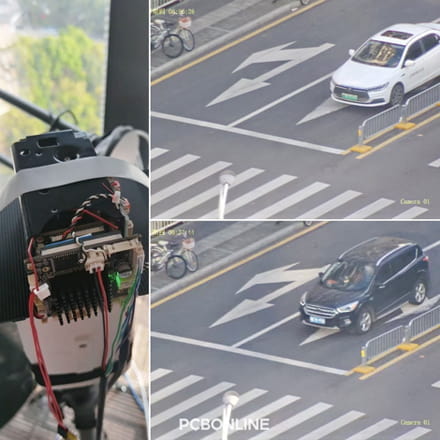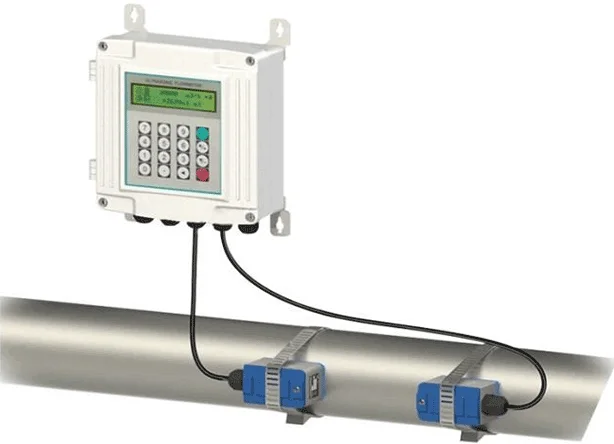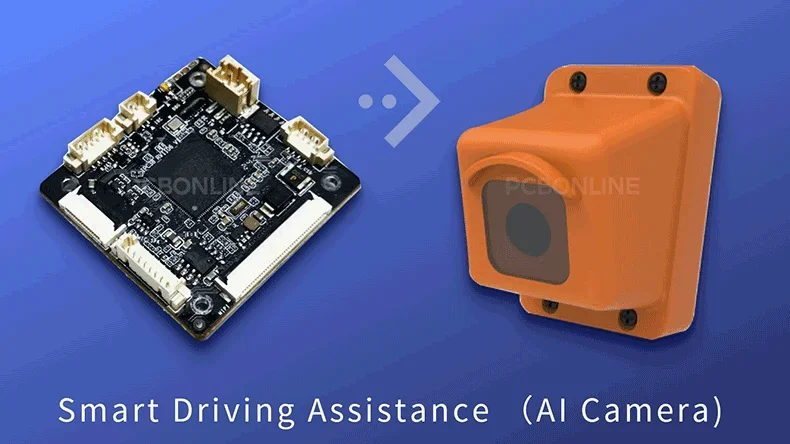Industrial automation relies on sensors. Industrial sensors include temperature, pressure, flow, position, LiDAR, machine vision cameras, encoders, and photoelectric sensors.
Printed circuit boards (PCBs) are the foundation of industrial sensors. The PCB inside an industrial sensor carries components and implements the sensing, signal conditioning, communication, and protection functions of the sensor.
PCBONLINE provides OEM PCB manufacturing for industrial controls, including industrial sensors. In this article, we break down industrial sensors, their PCBs, and their applications.

Characteristics of Industrial Sensors
Compared with consumer electronics, industrial sensors are built for long-term reliability in harsh environments. Before diving into each sensor, let's see the common characteristics that run across industrial sensor PCBs.
- High reliability and environmental resistance: Industrial sensors are exposed to oil, dust, vibration, moisture, and temperature extremes. Their PCBs are designed with high-TG FR4 laminates (TG170–TG185), optional ceramic or metal-core substrates, -40°C to +85°C or +105°C operation, and vibration-resistant component mounting and mechanical reinforcement.
- Strong EMC/EMI design: Industrial sensor signals are often microvolt or milliamp level and easily disturbed. Industrial sensors rely on clear analog–digital separation, ground partitions (digital ground, analog ground, shield ground), shielding cans or metal housings, and multi-layer stackups for stable reference grounds.
- Thicker copper: While consumer electronics commonly use 1 oz copper, industrial sensors often require 2oz or more for higher current handling, better surge resistance, and lower trace heating over long duty cycles.
- Moisture, corrosion, and ingress protection: Manufacturing of Industrial sensors often demands conformal coating, silicone or epoxy potting, ENIG or hard-gold plating on pads, and protective enclosures rated at IP65/67+.
- Isolation and signal conditioning: Sensors frequently interface with PLCs, motors, and high-voltage industrial systems. Therefore, industrial sensor PCBs include signal isolation (opto-isolators or digital isolators), instrumentation amplifiers, low-noise ADC circuits, and galvanic isolation for safety.

Industrial sensors include a wide range. Now, let's dive sensor by sensor into the specific industrial sensor applications.
Temperature Sensor Applications and PCBs
Temperature sensors are among the most widely used industrial devices. They center around precision, low noise, and compensation circuitry.
Applications:
- Food processing
- HVAC systems
- Industrial ovens and boilers
- Chemical reactors
- Medical and laboratory equipment

Temperature signals are small, especially with thermocouples, which generate microvolt-level outputs. Temperature sensor PCBs include:
- Instrumentation amplifiers with high common-mode rejection
- Cold-junction compensation ICs for thermocouples
- Low-noise layout, short analog paths, ground shielding
- Temperature drift compensation using precision resistors
- Often, 4-layer designs for clean analog grounding
The PCB determines accuracy. Poor layout causes noise, offset, and temperature drift, leading to an inaccurate measurement.
Pressure Sensor Applications and PCBs
Industrial pressure sensors rely on MEMS diaphragms paired with highly sensitive amplification circuits.
Applications:
- Hydraulic and pneumatic systems
- Oil and gas pipelines
- Air compressors
- Automotive braking systems
- Chemical process control
Pressure sensor signals often require a dedicated analog front-end for amplification, temperature compensation circuits, digital interfaces such as SPI or I²C, shielding cans to protect the MEMS element, and high reliability against moisture, oil, and vibration.
Many pressure sensor PCBs are completely potted, leaving only the connector exposed, ensuring a long lifetime in harsh environments.
Flow Sensor Applications and PCBs
Flow sensors vary in design depending on the medium, such as air, gas, or liquid, and the underlying measurement method.
Applications:
- Water flow monitoring
- Airflow measurement in HVAC and compressors
- Gas pipelines
- Industrial chemical dosing

Thermal mass flow sensors use heating elements, so the PCB needs:
- Higher copper thickness (1–2 oz) for stable current delivery
- Precision temperature sensing front-ends
- Stable digital control circuits controlling heater output
Ultrasonic flow sensors require high-voltage drivers for transducers, time-of-flight measurement ICs, and controlled impedance paths for high-frequency signals.
Their PCBs often resemble small mixed-signal boards with precise analog timing circuits.
Position and Motion Sensor Applications and PCBs
Position sensors, especially rotary encoders, are essential in motors, robotics, and industrial automation.
Applications:
- Servo motors
- CNC machines
- Industrial robots
- Conveyor systems
- Elevators

Position-sensing PCBs depend on accuracy and stable high-speed signal processing:
- Magnetic or optical sensing components
- High-speed differential outputs (A/B/Z channels)
- Clean power supply for stable signal thresholds
- Often combined rigid-flex PCB structures for sensor alignment
- High-frequency filtering to suppress motor noise
In optical encoders, alignment holes and mechanical tolerances on the PCB are critical to meet precision requirements.
LiDAR Sensor Applications and PCBs
LiDAR is no longer limited to autonomous vehicles, and it's used in industrial safety, robotics, warehouse automation, and AGV navigation.
Applications:
- Industrial robots and AGVs
- Mapping and navigation
- Collision avoidance systems
- Logistics and warehouse scanning

LiDAR sensors are demanding industrial sensors because they integrate high-power laser driver circuits, APD (avalanche photodiode) receivers, high-speed time-of-flight (ToF) processors, controlled impedance differential pairs, and HF materials (Rogers, Isola, Panasonic Megtron) for signal integrity.
A LiDAR sensor is a miniaturized high-speed electronic system. LiDAR sensor PCBs are 6–12 layers with:
- Dedicated analog layers
- Dedicated digital/MCU layers
- Internal solid ground planes for EMC
- Shielding and thermal management features
Machine Vision Sensor Applications and PCBs
Machine vision cameras are the eyes of industrial automation, used in AI inspection, measurement, quality control, and robotics.
Applications:
- AI visual inspection
- Part recognition
- Barcode and QR scanning
- Defect detection
- Assembly line monitoring

Machine vision PCBs share characteristics with smartphone camera modules, but with higher reliability and industrial protection:
- High-speed image sensors (Sony IMX, Onsemi, Omnivision)
- MIPI CSI-2 or LVDS differential pairs requiring strict impedance control
- Dedicated power regulation for sensor noise reduction
- Rigid-flex PCBs connecting the lens module and the processing board
- Metal housings and shielding for image quality stability
- Often, 6–8 layer stackups for stable ground returns
Proper PCB grounding directly affects sensor noise, image clarity, and frame stability.
Photoelectric and Optical Sensor Applications and PCBs
Photoelectric sensors are fundamental in industrial automation for object detection and distance measurement.
Applications:
- Packaging and bottling lines
- Material detection
- Counting and positioning
- Safety interlocks
- AGV line tracking

Photoelectric sensors include IR LEDs and photodiodes, high-gain amplifier circuits, filters for ambient light immunity, adjustable sensitivity control or auto-calibration ICs, and sealed housings and potted PCBs for IP67 environments.
4 to 6-layer PCBs ensure ground integrity and reduce optical noise interference.
PCB Quality Impacts Industrial Sensor Performance
Industrial sensor PCBs execute most of the sensing, amplification, conversion, and communication functions. Their PCB design directly affects:
- Measurement accuracy
- Signal stability and noise immunity
- Sensor lifetime
- Environmental reliability (moisture, temperature, vibration)
- Safety and isolation performance
For industrial customers, choosing a high-quality PCB and manufacturer is as important as selecting the sensor itself. PCBONLINE, a one-stop advanced PCB manufacturer focusing on industrial control fields, is the one you can choose that provides reliability, engineering support, and cost-effectiveness.
Partner with PCBONLINE for Industrial Sensor PCB OEM
PCBONLINE is a PCBA original equipment manufacturer focusing on industrial controls, including industrial sensors. We provide all the electronics manufacturing and materials used for industrial-grade PCB box-build assembly services, including the PCB enclosures.
Our OEM PCBA manufacturing services offer:
- Turnkey PCBA manufacturing from prototypes to mass production, including PCB fabrication, component sourcing, PCB assembly, conformal coating, IC programming, burn-in test, functional test, and box-build assembly.
- Complete procurement: We source and customize enclosures, cables, and accessories from reliable suppliers.
- Engineering support: We check enclosure and accessory designs for compatibility with your PCBA and can suggest design changes.
- Free DFM/DFT: We provide free Design for Manufacturability (DFM) and Design for Testability (DFT) checks to ensure that designs are optimized for a smooth production process.
- Quality assurance: IPC-A-610 Class 3, automotive-grade or industrial-grade inspection standards.
- Turnkey delivery: From PCB fabrication to final product packaging and shipping.
- Testing and value-added services: Offering a range of quality assurance services, including X-ray inspection for hidden-joint PCBAs, first-article inspection, PCBA functional testing (FCT), IC programming, burn-in test, PCBA coating, enclosures, and box-build assembly.
Founded in 2005, we have one-stop industrial control PCB assembly capabilities, two large advanced PCB manufacturing bases, one PCB assembly factory, stable supply chains, and an R&D team. We provide free DFM (design for manufacturing) and one-stop PCBA manufacturing. You can work with PCBONLINE to turn your industrial control project into products.

PCBONLINE offers free DFM before and during PCBA prototyping to debug design defects and solve unexpected issues to ensure the success of your industrial control board, including Gerber, BOM (bill of materials), manufacturing process design, testing, IC burn-in programming, and enclosure.
PCBONLINE has dominant advantages in industrial control PCB assembly, providing engineering support in hardware building, and even our development according to your initial idea.
Industrial control projects often finally go to the mass production stage. When your industrial control PCB assembly project goes to mass production, PCBONLINE will refund you the fees of R&D, prototyping/sampling, and offer free PCBA functional testing.
High-quality industrial control PCB assembly and final product assembly certified with IPC-A-610 Class 3, ISO 9001:2015, IATF 16949:2016, RoHS, REACH, and UL.
PCBONLINE has manufactured many successful industrial control PCB assembly projects. To get a quote for your industrial controls, including industrial sensors, please email info@pcbonline.com. Once you contact us, we will provide you with one-on-one engineering support.
Conclusion
Industrial sensors are responsible for signal acquisition, processing, conditioning, communication, and environmental durability. They include temperature sensors, pressure sensors, flow sensors, encoders, LiDAR, and photoelectric sensors. This article lists their applications sensor by sensor. To order turnkey PCBA assembly for industrial sensors, contact us to start your project.




